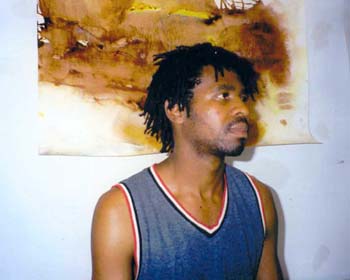

My work is based on what is around me, my environment, and I am inspired a lot by the elements of nature and I study rock formations and the cave paintings and just a lot that has to do with nature, because I believe that as human beings we are spiritual beings as well. So art is a universal language, and our inspiration as spiritual beings and as human beings has to do a lot with our surroundings, nature. If you are akin to nature, it actually provides you with peace. You have peace within yourself, because it gives you time to meditate and express yourself, because as human beings, we are always desperate. We don’t know. We always act desperate to express ourselves, and we are always desperate to discover more about ourselves and what influences us apart from things that are man-made. So we always have to go back to refer and we always want to be uplifted and to revive ourselves spiritually. So nature provides us with possibilities of expressing ourselves and finding a way of finding peace within ourselves.
The other work that I do is working a lot with the work I find that inspires me and what I like the most is creating art work and to be innovative, because I believe that with art you don’t come and create, but as human beings everything when we come to this world, we find everything there, so we just revive what is there. And I am inspired a lot by the rock paintings, because for me they are not very conceptual. They are very natural, because it’s something that is there that you learn when you see it. You just have to add whatever, and it has to do with mark-making, because mark-making is very, very important, and it is universal.
People express themselves when they mark themselves from scarifications to the way people want to identify themselves. Mark-making is a very simple way and it’s a very immediate way of people identifying themselves, and it has to do with where they come from. Wherever people are they always want to mark their spots, so that they feel that they belong there. They can find something that will make them feel it’s part of theirs, like nature. It starts from people who planted trees. The way people surround themselves, and spiritually as well, like the way people express themselves has to do sometimes with their background, where they come from. But as human beings we always want to discover ourselves as individuals and how we link to what is around us. When you start to grow up, you want to know how to connect with whatever. You know that you connect with your parents, but you want to go far beyond that.
My paintings are based mostly on what amazes me. What always amazes me is the mark-making. When I work, my work is something that I find. As a painter, I try not to paint, but when I have my material, which I call my material, to play around like a child. When I am painting, it makes me forget about who I am. I just become who I am naturally as a child. And I enjoy working down like I’m playing, because that actually connects me with everything that exists as to capture the movement and the rhythm, whatever that is there. And it enhances my spirit and psychologically I become free. I don’t want to feel that I impose on the material I am using, but using whatever the material, the surface is playing around and making marks, and not only my marks, but there are marks that are already there but I make them. I don’t have to fake or to look at a photograph. It is just something my eye records, and my spiritual eye records, as some things that inspire me a lot, like the cave paintings in South Africa.
We call the paintings umzorba wabatwa. Abatwa, they are indigenous of South African people. What I like about them is their ability to heal through art, through dance. When Abatwa do their dance, it is related to nature and it is related to them. It is to heal themselves, and art is part of their lives. Because Umzorbo, they would work in Columbia in retreats. It is like it would be in the mountain, which we call the mountain Amawain or Endarain. They do the ritual dance and they walk around, they circle around, and then when it is full moon for them it is good time to heal themselves through the dance.
Dinkies Gladstone Sithole. Painter, sculptor, dancer, percussionist. Soweto, South Africa. As a painter/sculptor, Mr. Sithole has exhibited at the Johannesburg Biennale, Second National Cultural Festival-Pretoria, and Funda Arts Center, Soweto, among others. As a dancer, he has performed internationally, including the Maitisong Art Festival, Botswana; Grahamstown Arts Festival; FNB Vita Awards Show; Edinburgh Festival, Scotland.